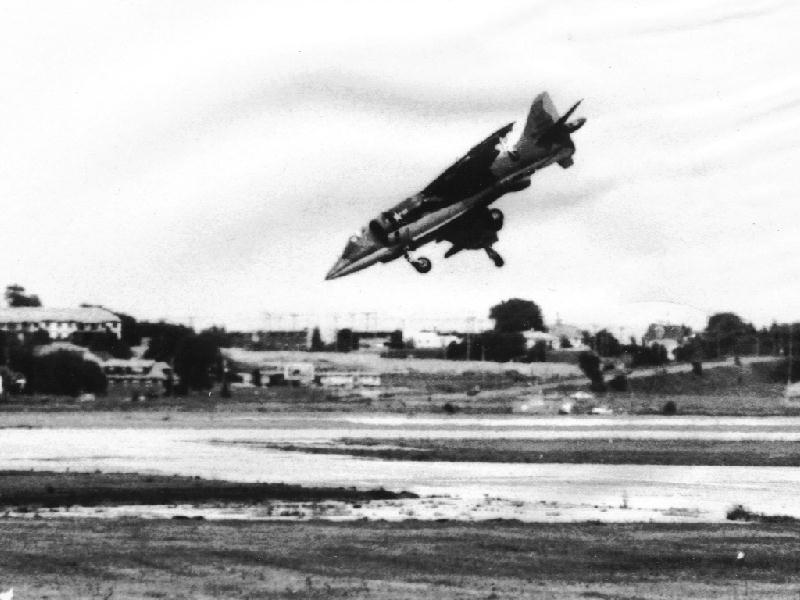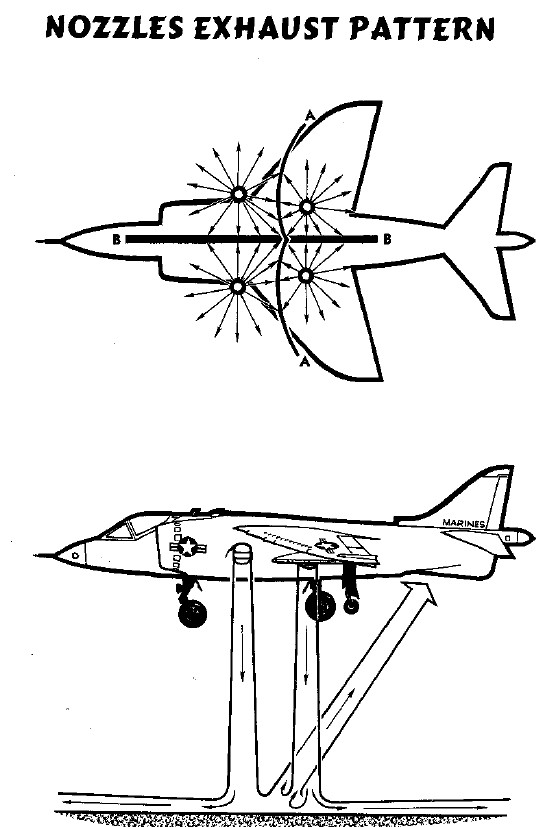 The Ejection Site
Surviving the Unsurvivable
The Ejection Site
Surviving the Unsurvivable
 The video is hard to watch as a hovering AV-8A Harrier suddenly lurches nose down and slams into the ground erupting in flames and smoke. From the debris a tumbling object appears, legs sticking out being the primary clue that there is a man involved. It spins and a small white streak heralds the seats attempt to deploy the parachute but the low altitude and poor ejection conditions didn't give it time to work. The seat slams into the ground and the video ends. If that was all you would expect to have heard later that it was unsurivivable but then the newspaper says he survived with a broken nose! Of course this was an early, very optimistic report, yet the key part was he survived the mishap. I came across the video on Youtube and will have a link at the end of the article. It mentioned the pilot, Steven Torrent was still alive so I reached out and asked for his story. Here, in his own words, it is!
The video is hard to watch as a hovering AV-8A Harrier suddenly lurches nose down and slams into the ground erupting in flames and smoke. From the debris a tumbling object appears, legs sticking out being the primary clue that there is a man involved. It spins and a small white streak heralds the seats attempt to deploy the parachute but the low altitude and poor ejection conditions didn't give it time to work. The seat slams into the ground and the video ends. If that was all you would expect to have heard later that it was unsurivivable but then the newspaper says he survived with a broken nose! Of course this was an early, very optimistic report, yet the key part was he survived the mishap. I came across the video on Youtube and will have a link at the end of the article. It mentioned the pilot, Steven Torrent was still alive so I reached out and asked for his story. Here, in his own words, it is!
 Well sir, you have a good understanding of the Harrier systems. Now just a little tweak so you will understand some of the complexities of vertical flight and transition from jet borne flight to wing borne flight. We have what is euphemistically called a whiz wheel much like the E-6B. For vertical takeoff or landing you spin the wheel to your weight and field elevation which results in an acceptable weight. For short takeoff or landing (RVTO rolling vertical takeoff, RVL rolling vertical landing) you once again spin the wheel to your weight and field elevation, and you get a speed and nozzle angle. For the takeoff you move the nozzle stop on the nozzle lever board to the stated angle. Advance the throttle and as the aircraft reaches the computed speed you slap the nozzle lever back until it reaches the stop. The aircraft jumps in the air, you catch it and fly away. The nozzles rotate from straight aft to 81 degrees down. The aircraft is at a 9 degree nose up attitude on the deck. So, 9 degrees nose up, 81 degrees nozzles down you have the 90-degree thrust vector for vertical takeoff and landing. The early AV-8A aircraft were equipped with Martin Baker [Mk. 9A] seats.
Now to 27 July 1974 Transaire air show. I was flying an AV-8A. I did the show starter of an RVTO. Once airborne I came back around for the high-speed low pass. That done I approached field center for the bow to the crowd. The bow is done by basically rotating the aircraft around the nozzles. I dropped the nose a little more aggressively than normal and immediately realized I needed to fix this. Full power and full aft stick would have opened the front puffer and brought the nose up to the hover position. As I advanced the power the aircraft lurched forward nose down.
After much accident investigation and video review it was figured out that as I advanced the throttle lever my glove contacted the nozzle lever resulting in the nozzles going straight aft! I didn't realize this at the time, I just saw the lurch. So, a 10-degree nose down attitude and approx. 17,000 pounds of thrust instantly changed to 21,000 pounds of thrust with nozzles suddenly straight. Where I was going was fairly academic. However, flashing through the mind of a proud Marine the thought "don't jump out and look bad at an airshow!"! So, I impacted the deck still trying to fly it.
Well sir, you have a good understanding of the Harrier systems. Now just a little tweak so you will understand some of the complexities of vertical flight and transition from jet borne flight to wing borne flight. We have what is euphemistically called a whiz wheel much like the E-6B. For vertical takeoff or landing you spin the wheel to your weight and field elevation which results in an acceptable weight. For short takeoff or landing (RVTO rolling vertical takeoff, RVL rolling vertical landing) you once again spin the wheel to your weight and field elevation, and you get a speed and nozzle angle. For the takeoff you move the nozzle stop on the nozzle lever board to the stated angle. Advance the throttle and as the aircraft reaches the computed speed you slap the nozzle lever back until it reaches the stop. The aircraft jumps in the air, you catch it and fly away. The nozzles rotate from straight aft to 81 degrees down. The aircraft is at a 9 degree nose up attitude on the deck. So, 9 degrees nose up, 81 degrees nozzles down you have the 90-degree thrust vector for vertical takeoff and landing. The early AV-8A aircraft were equipped with Martin Baker [Mk. 9A] seats.
Now to 27 July 1974 Transaire air show. I was flying an AV-8A. I did the show starter of an RVTO. Once airborne I came back around for the high-speed low pass. That done I approached field center for the bow to the crowd. The bow is done by basically rotating the aircraft around the nozzles. I dropped the nose a little more aggressively than normal and immediately realized I needed to fix this. Full power and full aft stick would have opened the front puffer and brought the nose up to the hover position. As I advanced the power the aircraft lurched forward nose down.
After much accident investigation and video review it was figured out that as I advanced the throttle lever my glove contacted the nozzle lever resulting in the nozzles going straight aft! I didn't realize this at the time, I just saw the lurch. So, a 10-degree nose down attitude and approx. 17,000 pounds of thrust instantly changed to 21,000 pounds of thrust with nozzles suddenly straight. Where I was going was fairly academic. However, flashing through the mind of a proud Marine the thought "don't jump out and look bad at an airshow!"! So, I impacted the deck still trying to fly it.

The aircraft exploded on impact. The inertial reel broke on impact, so I rocked forward in the seat breaking my visor and mask on the glare shield. (#1 good thing) At the same time the explosion cooked of the ejection seat initiator charge which started me up the rails in the bent over position. My helmet hit the metal part of the canopy bow and my top half stop rising. This resulted in a broken bone or 2 in the neck. The seat however, continued up the rails with my lower half, compressing 5 vertebrae and breaking 4 ribs. The seat came loose from the rails and started rotating around me.
When a pilot initiates ejection, the det cord embedded in the canopy shatters the canopy. Since I didn't initiate the ejection, the canopy didn't know I was coming so still rotating I went through the intact canopy. The 6-foot-long pigtail that fires the rocket to give you 400 feet of altitude for parachute activation couldn't take the angle of the seat and broke. (#2 good thing) The back of my helmet sheared, and I was free of the aircraft in an extreme head down attitude. Had the rocket fired I would have been launched right back into the fireball.
 You can watch the seat on the video make 2 and 3/4 neat turns landing me flat on my back still strapped in the seat, (#3 good thing) just outside the fireball. Only my right arm was under the seat on landing resulting in a compound fracture of the elbow. A face first landing with the seat on top of me might not have been survivable. Had I not broken the visor and mask I would have suffocated in the seat.
The Sheriff arrived and dragged my seat away from the wreck. I was conscious through this whole episode though a little woozy from the canopy bow impact. There was absolutely no pain. I guess I activated so many pain sensors in the body the brain couldn't keep up.
Injury list. Compound fracture of the right elbow. 5 compressed vertebrae (they didn't fully pop back up, so I am a 1/2 inch shorter). 4 broken ribs, A couple of small broken bones in the neck. Various cuts and bruises from going through the canopy. A couple of burns on the face do to broken visor. A large burn on the right wrist that required a skin graft.
3 months later I passed my flight physical and was back to full duty, flying, skydiving and rodeo riding.
There you have it. Martin Baker Sent me a tie and pin and added me to the MB seat saves lives list. It did get me out of the aircraft and didn't send me back into the fireball. You can see on the video the drogue chute making a valiant effort, but we just didn't have the altitude for a chute.
Photos Provided by Stephen C. Torrent, diagrams from USMC AV-8A manual
You can watch the seat on the video make 2 and 3/4 neat turns landing me flat on my back still strapped in the seat, (#3 good thing) just outside the fireball. Only my right arm was under the seat on landing resulting in a compound fracture of the elbow. A face first landing with the seat on top of me might not have been survivable. Had I not broken the visor and mask I would have suffocated in the seat.
The Sheriff arrived and dragged my seat away from the wreck. I was conscious through this whole episode though a little woozy from the canopy bow impact. There was absolutely no pain. I guess I activated so many pain sensors in the body the brain couldn't keep up.
Injury list. Compound fracture of the right elbow. 5 compressed vertebrae (they didn't fully pop back up, so I am a 1/2 inch shorter). 4 broken ribs, A couple of small broken bones in the neck. Various cuts and bruises from going through the canopy. A couple of burns on the face do to broken visor. A large burn on the right wrist that required a skin graft.
3 months later I passed my flight physical and was back to full duty, flying, skydiving and rodeo riding.
There you have it. Martin Baker Sent me a tie and pin and added me to the MB seat saves lives list. It did get me out of the aircraft and didn't send me back into the fireball. You can see on the video the drogue chute making a valiant effort, but we just didn't have the altitude for a chute.
Photos Provided by Stephen C. Torrent, diagrams from USMC AV-8A manual
Youtube video
 The Ejection Site
Surviving the Unsurvivable
The Ejection Site
Surviving the Unsurvivable
 The Ejection Site
Surviving the Unsurvivable
The Ejection Site
Surviving the Unsurvivable

